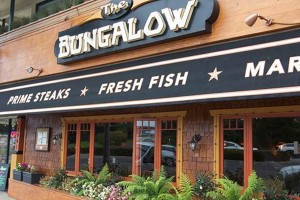By Christopher Trela & Catherine Del Casale | NB Indy
What are Newport Beach’s three main attributes that draw visitors to our city while enticing resident to get out and about? Our beaches and waterfront, world class shopping, and dining.
 Dining has indeed become an important aspect of commerce in the city. According to Jim Walker, longtime owner of The Bungalow and president of the Newport Beach Restaurant Association, there are more than 15,000 seats available in the city’s restaurants.
Dining has indeed become an important aspect of commerce in the city. According to Jim Walker, longtime owner of The Bungalow and president of the Newport Beach Restaurant Association, there are more than 15,000 seats available in the city’s restaurants.
So what does it take to fill those seats?
We sat down with Walker and his new business partner, Louie Feinstein (formerly with Grill Concepts and GM of the Daily Grill in Fashion Island), to talk about the business of dining.
NBI: First, how did the new business partnership come about?
Feinstein: I have known Jim over the years, and known of The Bungalow. About two years ago I retired from Grill Concepts. I live in Costa Mesa, and had heard that Jim was maybe looking to sell the restaurant, but it never came to be, so we started talking about forming a partnership. We talked, it evolved, and it’s a good partnership. We knew where The Bungalow had been and what we looked forward to in the future.
Walker: I’ve had the restaurant for 14 years, it’s been here 17 years as of October. It’s been a great ride, the restaurant is a local landmark, and we have a great relationship with the community, which is where most of our business comes from, not so much the tourist business. September and October are typically slow months for us but September was up 10 percent over last year, October was good, and we’re continuing to improve on what we have.
NBI: Does that mean the economy has come back and people are dining out more?
Walker: People are getting used to the new normal, but a contradiction to that is an element of price value. Mastros is expensive and packed, so people are willing to spend more money. We have tried to diversify the menu to offer more than steak and seafood. We now have a bar menu with more options, and we try to widen our customer base via different price points.
Feinstein: Jim has established a loyal guest base, and we want to capitalize on that and reach a younger demographic that may not have tried The Bungalow. We’re reaching out through social media to reach that demographic to come in and try us.
Walker: Restaurants have to reinvent themselves all the time, if not you become something in the past. There are some restaurants that have been around for a long time, their customer base is aging, and they’re not replacing them with a different customer base. I remodeled the patio, remodeled the restaurant and made it more contemporary in line with trends. We’re trying to lower the average age of the person that comes into The Bungalow, We have changed our format in the bar, offering craftsman style cocktails and draft beers, geared to a younger demographic. We’ve been perceived as a special occasion restaurant, and we’re trying to change that image. We’re looking at opening for lunch and create different revenue streams. This area has become more of a lunch destination. We get calls every day asking if we’re open for lunch.
Feinstein: Right now we’re just a dinner house, we open at 5 p.m. so having the lunch revenue would change the dynamics.
Walker: When you think about it, we have such a small window of time in which to do business. We really only have a two hour window to do 80 percent of our business. That’s why lunch is an alternative, if we can do enough business at lunch to pay the rent, that takes a big load off of the demand of just being open for dinner. With minimum wage going up…if we raise minimum wage by $1 an hour, that’s $2500 a month it costs us. If we work on 10 percent profit, that’s $25,000 a month we have to increase our business just to break even. That’s $300,000 a year. What restaurant do you know that’s going to raise their volume by $300,000 overnight? We need to think of other revenue models.
NBI: How is the Restaurant Association working with the local restaurants?
Walker: We market the restaurants in Newport Beach locally, trying to attract people outside of Newport. Over 400 food facilities in the city pay a fee, we generate $160,000 in fees and take that money and use it for magazine ads, radio, whatever we need. I did a study a few years ago to find out the seating capacity of Newport Beach from a restaurant standpoint, so I went to the fire department and asked for the occupancy for all the restaurants that have seating. When I calculated it, the seating capacity is 15,000 at any given seating. That’s about 500,000 seats a month. The population of Newport Beach is 87,000, so if every man, woman and child ate out five times, we could fill the restaurants, but they don’t. That’s why we have to have people come in from other cities. That’s why it’s so competitive, and why people expect more. People have plenty of choices, so if we don’t do a good job, that loyalty will not exist. There are more restaurants coming into town, and if each restaurant only takes three percent of our business, with five new restaurants, that’s 15 percent. If we lose 15 percent of our business, we have a real problem. We are in a very competitive market. There is lots of discretionary income, but people still want value, service, quality, and performance.
NBI: With so many restaurants and seats to fill, is there room for more restaurants?
Walker: There is a feeling that Fashion Island is becoming the restaurant capital of Orange County, and especially Newport Beach. There is a saturation effect, but like any business it’s survival of the fittest. It raises the bar. Those that can meet that level will survive, those that don’t will fall by the wayside.
Feinstein: I’ve learned to never be afraid of competition, it’s what drives you to do better. We’re going to go up against the big guys, but we understand what we have to do, and we will survive and grow.




